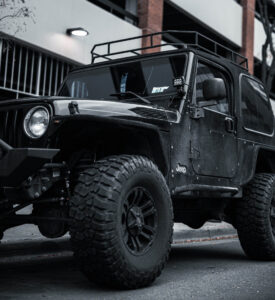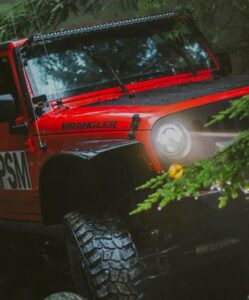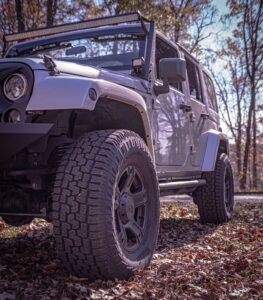Body lifts are a body modification for your jeep that can help you in a variety of ways. One good way body lifts can be beneficial is by giving you the ability to run larger tires and wheels on your jeep, which will give you better traction and control when off-road driving.
However, body lifts can also negatively affect jeeps, such as by increasing the risk of engine damage due to uneven suspension loads or creating problems with clearance between other parts like bumpers and headlights.
So before deciding whether or not body lifts are suitable for your jeep, it’s important to do some research first!
Contents
What is a Body Lift?
A body lift is a popular modification for many jeeps. A body lift kit can be used to raise your jeep’s body by an inch or more, which allows you to install bigger tires on your jeep without having to do any other modifications (like cutting and drilling).
Body lifts are also great because they allow extra clearance to install body armor, making your jeep safer in a collision.
Body lifts are known to give Jeeps an aggressive look. Many people love body lift modifications because they allow for extra clearance without suspension modifications. Below you can find a TeraFlex 2″ leveling kit.

How Does the Body Lift Process Work?
The body lift process is a body modification that lifts your jeep’s body from it’s chassis, so it can be adapted to have larger tires.
The process requires an expert to do the lifting, but you can also do it yourself in your garage if you have the correct information about lifting your jeep.
After the body has been lifted, you may need new fender flares and bumpers for everything to fit correctly.
Not only that, sometimes you may need to modify steering components, gear shift components, exhaust components as well as electronics wire connections according to the level of lift you are doing.
You may also want some aftermarket rims, or replacement LED lighting installed into your jeep body once all of this work is done. Many companies in the market today specialize in these types of modifications.
How to Install a Body Lift on Jeep?
When installing a body lift, all body lifts are installed similarly with slight differences, which may be how they bolt down.
After installing, you will get a little more life and space for tires without being bothered about the suspension components since you only move the body and not the frame.
Most body lift comes with a raiser used to raise the bumper to eliminate any gap and the need to remove shifter boot.
The first thing to do is park your jeep on a levelled ground and activate the parking brake for safety measures.
For this process, you have to do the lifting on one side before moving to the other, and most jeeps have 5 to 6 mounts on each side.
After removing all the bolts, take your jeep’s jack and jack up the body of the jeep high enough such that the body lift can conveniently stay between the frame and the body. In this case, you may need another jack to lift the front and back a little bit to get the body lift in.
After this is done, replace the old bolts that you removed with those that came with the body lift. Attaching a washer in this stage is very important before nutting the bolts.
You can use the old washer on the new bolts if you don’t have a new washer.
The next thing you have to do is repeat this same process for the other side of your jeep, and you have successfully installed a body lift on your jeep.
Benefits and Disadvantages of Installing a Body Lift on Jeep
Body lifts can be good and bad for your jeep! However, it depends on what you use them for and how much lift you put into your vehicle. Some of the benefits and disadvantages are discussed below:
Benefits of Installing a Body Lift on Jeep
- It encourages additional modifications such as installing new bumpers or adding bigger wheels without interference from other components on the bottom side of the vehicle.
- The body kit is designed to raise or elevate the body slightly so that there is enough space between its underside components and the ground to provide ample clearance when travelling over obstacles like rocks.
- Body lifts are safer because body components like the exhaust system or gas tank won’t be as close to the ground, which means they’ll stay out of harm’s way.
Disadvantages of Installing a Body Lift on Jeep
- Main disadvantage is you may need to modify electronic wire connections, exhaust components and shifter components accordingly to work fine with the new space between jeep body and chassis.
- Your body lift may make your jeep look like an off-road vehicle (This may not be a disadvantage for some users). Sometimes there can be created ugly looking spaces between jeep body and frame specially from front and rear bumper areas.
- Even the spacer kits are cheap and body lifting seems like a budget friendly option, sometimes you may end up spending the same amount of money on suspension lifts when solving other issues coming with electronic, steering and shifter components after a body lift.
- Jeep owners may get in trouble with car insurance companies. Because they may consider it to be “modification” and you have to follow the lifting regulations in your location.
- Jeep body lifts are not suitable for aerodynamics. This is because body lifted jeeps have less wind resistance, which lowers the fuel efficiency of the vehicle.
- Body lifts require proper care for them to work correctly over time so that they don’t wear down prematurely from rusting or being damaged too much when driving over obstacles in their path.
- There must be enough space between other parts under the vehicle, such as mufflers and fuel tanks, so these odious items don’t cause damage-prone interference with body components or falling off while you’re driving.
The Cost of Having a Body Lift Done on Your Jeep
A body lift for a jeep may vary in cost depending on several factors. Ranging from location to how high you want to lift your jeep.
However, a body lift may cost as low as $150 and as high as $850. A body lift for 1 inch to 2.75 inches may cost within $150-$250, while a lift of about 3.75 inches may cost up to $500 or more.
Lifting a jeep wrangler more than 4 to 5 inches will cost a much higher price of about $1500. At the same time, a basic body lift will cost about $400 or more, depending on your location.
Conclusion
One of the most beneficial reasons to get a body lift is by giving you the ability to run larger tires and wheels on your jeep without suspension modifications.
This may also give you better traction and control when off-road driving, which can mainly be helpful if you want to take your jeep up in the mountains or through water crossings.
However, everything that has advantages comes with its disadvantages. Compare and weigh your options before considering Jeep body lifting.
If you think this guide may be helpful for someone else, you can share this with them. You just have to hit one of the share buttons below.
Peace!!



